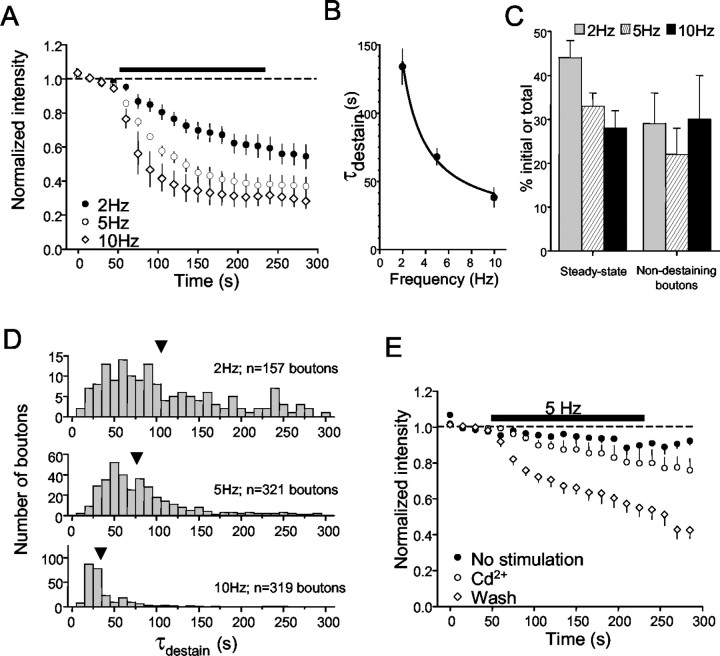Figure 3.
Frequency dependence of destaining. A, Group data showing destaining induced by different field stimulation frequencies. The numbers of boutons in each of the 14 slices (2 Hz, 5; 5 Hz, 3; 10 Hz, 6) represented ranged from 33 to 147 (mean, 78 ± 10; different slices per frequency; no significant difference in numbers of loaded boutons between slices). B, The mean time constant of destaining is frequency dependent. The symbols represent the mean time constants of decay at the indicated frequencies obtained from the best fits of exponential curves to the data in A. The solid line is the fit of the data by an empirical equation, analogous to that used by Zakharenko et al. (2001), to illustrate the kinetics of destaining of boutons in CA1 s. radiatum: τdestain = τ(min) + q/f, where τdestain is the time constant of destaining, τ(min) is the minimal time constant at 10 Hz, f is the frequency of stimulation, and q is a fit constant. C, The steady-state level of fluorescence at the end of stimulation trains declines as the frequency of stimulation during the trains goes up. The numbers of nondestaining boutons remained constant across different frequencies of stimulation. D, Destaining data from each bouton were fit by single exponentials. The bar graph plots the distribution of the time constants for the indicated numbers of boutons that made up the groups in A (total, n = 797 boutons). Note the shift in the population means (arrows) to faster time constants as the frequency increases. E, Cd2+ prevents destaining. The filled circles represent fluorescence measurements from 154 boutons in three slices that were loaded, washed, and imaged normally but received no unloading stimulation. The slight decrease in fluorescence by the end of the trial is the result of photo-bleaching. Data represented by open circles were obtained from measurements of 159 boutons in three slices loaded in normal solution, washed for 20 min in ADVASEP-7 plus 100 μm Cd2+, and then stimulated at 5 Hz (black bar) still in the presence of Cd2+. Cd2+ was then washed from the chamber for ≥20 min, and the slices were stimulated again (open diamonds). Cd2+ essentially prevented destaining (cf. open circles and diamonds); the data in Cd2+ are not significantly different from the photo-bleaching data.

